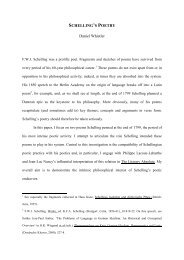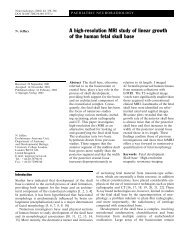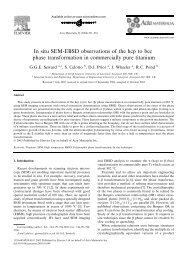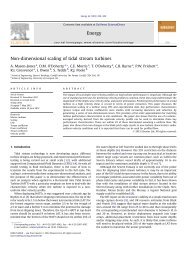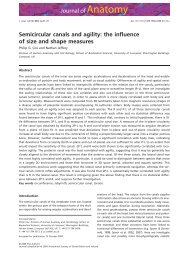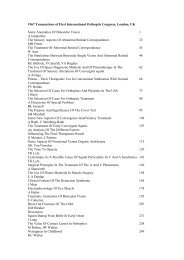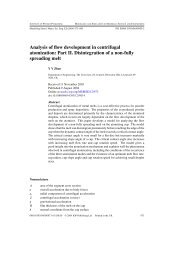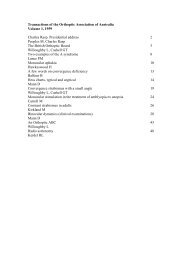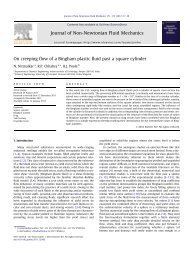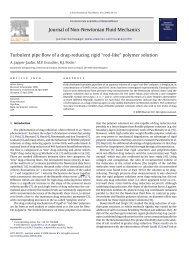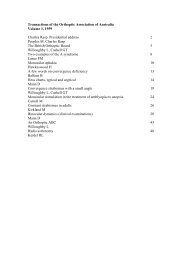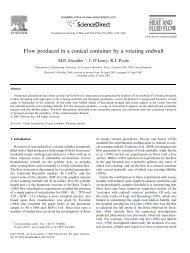Beyond the Pre-Pottery Neolithic B interaction sphere - University of ...
Beyond the Pre-Pottery Neolithic B interaction sphere - University of ...
Beyond the Pre-Pottery Neolithic B interaction sphere - University of ...
Create successful ePaper yourself
Turn your PDF publications into a flip-book with our unique Google optimized e-Paper software.
112 J World <strong>Pre</strong>hist (2006) 20:87–126<br />
example, that <strong>the</strong> procurement and manipulation <strong>of</strong> local and ‘‘exotic’’ materials alike<br />
were not focused on <strong>the</strong> production <strong>of</strong> trade items sensu stricto. Instead, <strong>the</strong>y generated<br />
objects that formed active ingredients in rituals and practices directly associated with <strong>the</strong><br />
definition <strong>of</strong> group and gender identities (Wright & Garrard, 2003). Fur<strong>the</strong>rmore, evidence<br />
on <strong>the</strong> distribution <strong>of</strong> types, and <strong>the</strong> densities <strong>of</strong> beads and bead-production debris indicates<br />
that production was small-scale and took place at <strong>the</strong> household level, while exchange was<br />
also small-scale (ibid.). A contextual case has also been made for <strong>the</strong> prominent role <strong>of</strong><br />
zoomorphic clay figurines as constituent parts ‘‘in performative acts which established<br />
symbolic equivalence between resources regularly mobilized in social exchange’’ in <strong>the</strong><br />
context <strong>of</strong> negotiating and consolidating local and regional (kinship-based?) alliances<br />
(Wengrow, 2003, p. 153–154). Fur<strong>the</strong>rmore, with regard to <strong>the</strong> circulation <strong>of</strong> more utilitarian<br />
objects, such as <strong>the</strong> products <strong>of</strong> <strong>the</strong> naviform reduction technologies, <strong>the</strong> case can<br />
also be made against <strong>the</strong>ir perception as items <strong>of</strong> an organized regional ‘‘trade’’: in <strong>the</strong>ir<br />
majority raw materials were procured directly from <strong>the</strong> sources and reduced by groups and/<br />
or individual knappers engaging in part-time, community-bound craft specialization<br />
(Quintero & Wilke, 1995; for a discussion <strong>of</strong> <strong>the</strong> potential symbolic values <strong>of</strong> lithics, see<br />
Goring-Morris & Belfer-Cohen, 2001).<br />
Such evidence for <strong>the</strong> highly contextualized role <strong>of</strong> material culture within Early<br />
<strong>Neolithic</strong> societies runs counter to its conceptualization as a field <strong>of</strong> opportunistic <strong>interaction</strong>s<br />
between communities seeking to buy into networks that circulated mainly<br />
‘‘desirable’’ and/or ‘‘prestige’’ novelties in a quasi-entrepreneurial fashion (contra<br />
Watkins, 2003). It is something <strong>of</strong> an anachronism to espouse a modernist view <strong>of</strong> <strong>Neolithic</strong><br />
material culture and to separate it from its local and regional contexts <strong>of</strong> production<br />
and consumption. It seems likely, instead, that such material items were invested with<br />
multiple layers <strong>of</strong> local meanings, kinship relations and stories <strong>of</strong> individual/group quests<br />
that formed <strong>the</strong> fabric <strong>of</strong> socialization rituals, cosmologies and mythologies <strong>of</strong> origins<br />
embraced by each community, and which could have been shared, to varying degrees,<br />
within and between different areas. Such a perception renders possible a definition <strong>of</strong> Early<br />
<strong>Neolithic</strong> exchange (following anthropological research among non-state societies) as a<br />
social reality that ‘‘combined many aspects <strong>of</strong> social practice and numerous institutions<br />
characteristic <strong>of</strong> <strong>the</strong> society’’ hence enabling ‘‘<strong>the</strong> society to represent itself (to o<strong>the</strong>rs and<br />
to itself) as a whole’’ (Godelier, 1999, p. 40). It is such a perspective on <strong>the</strong> likely social<br />
dimensions <strong>of</strong> Early <strong>Neolithic</strong> exchange which leads me to argue here that viewing <strong>the</strong><br />
PPNB predominantly as an ‘‘<strong>interaction</strong> <strong>sphere</strong>’’ based on generic and largely under<strong>the</strong>orized<br />
notions <strong>of</strong> prehistoric trade, is misleading. In this sense, <strong>the</strong> PPNB <strong>of</strong> Western<br />
Asia very probably constituted a recognizable world but not a world system.<br />
Any attempt to reconstitute this ‘‘world’’ has to accept <strong>the</strong> fact that, in this case,<br />
archaeologists might feel <strong>the</strong>y have reached <strong>the</strong> limits <strong>of</strong> plausible interpretation: ethnographic<br />
research has little to <strong>of</strong>fer that might help us comprehend <strong>the</strong> socio-economic<br />
environments and networks <strong>of</strong> relationships comprising Early <strong>Neolithic</strong> social landscapes<br />
(Perlès, 2001, p. 305). A starting point for <strong>the</strong>ory building that might eventually allow us to<br />
push <strong>the</strong> limits <strong>of</strong> our knowledge fur<strong>the</strong>r is <strong>the</strong> economic basis <strong>of</strong> Early <strong>Neolithic</strong> societies.<br />
A great deal is known about food staples, processes <strong>of</strong> domestication and <strong>the</strong>ir attendant<br />
symbolic and ritual domains (see Verhoeven, 2004) but still very little about <strong>the</strong> social<br />
contexts in which foodstuffs were produced, processed, consumed, circulated and valued.<br />
Seeds and bones, like material culture, have <strong>of</strong>ten been used in <strong>the</strong> quest to identify areas<br />
<strong>of</strong> origins and, implicitly, centres <strong>of</strong> cultural ascendancy in <strong>the</strong> process <strong>of</strong> neolithization<br />
(Asouti & Fairbairn, 2007). Much less pragmatic research has been dedicated to exploring<br />
<strong>the</strong> social impacts <strong>of</strong> changes in food production strategies, especially with regard to <strong>the</strong><br />
123



